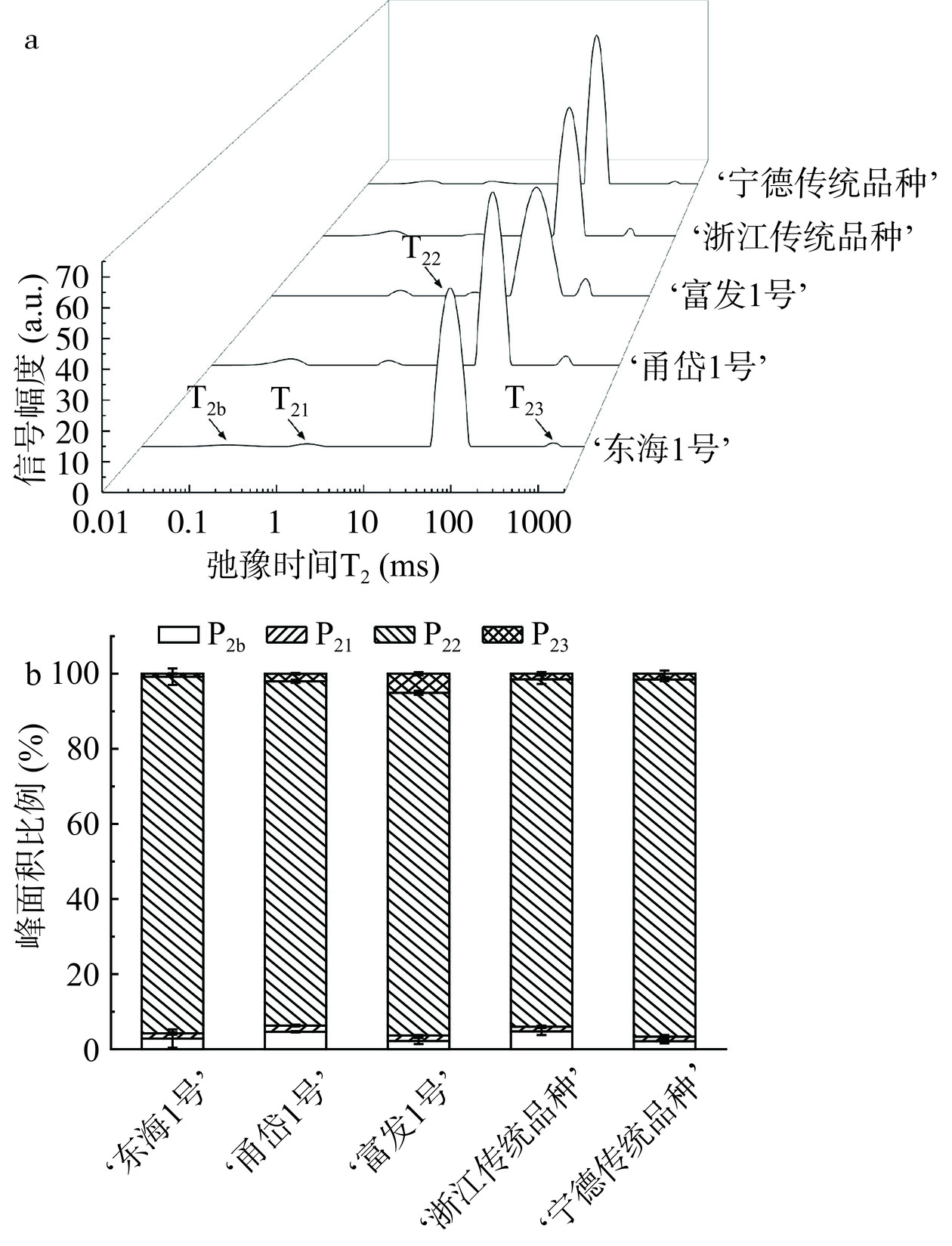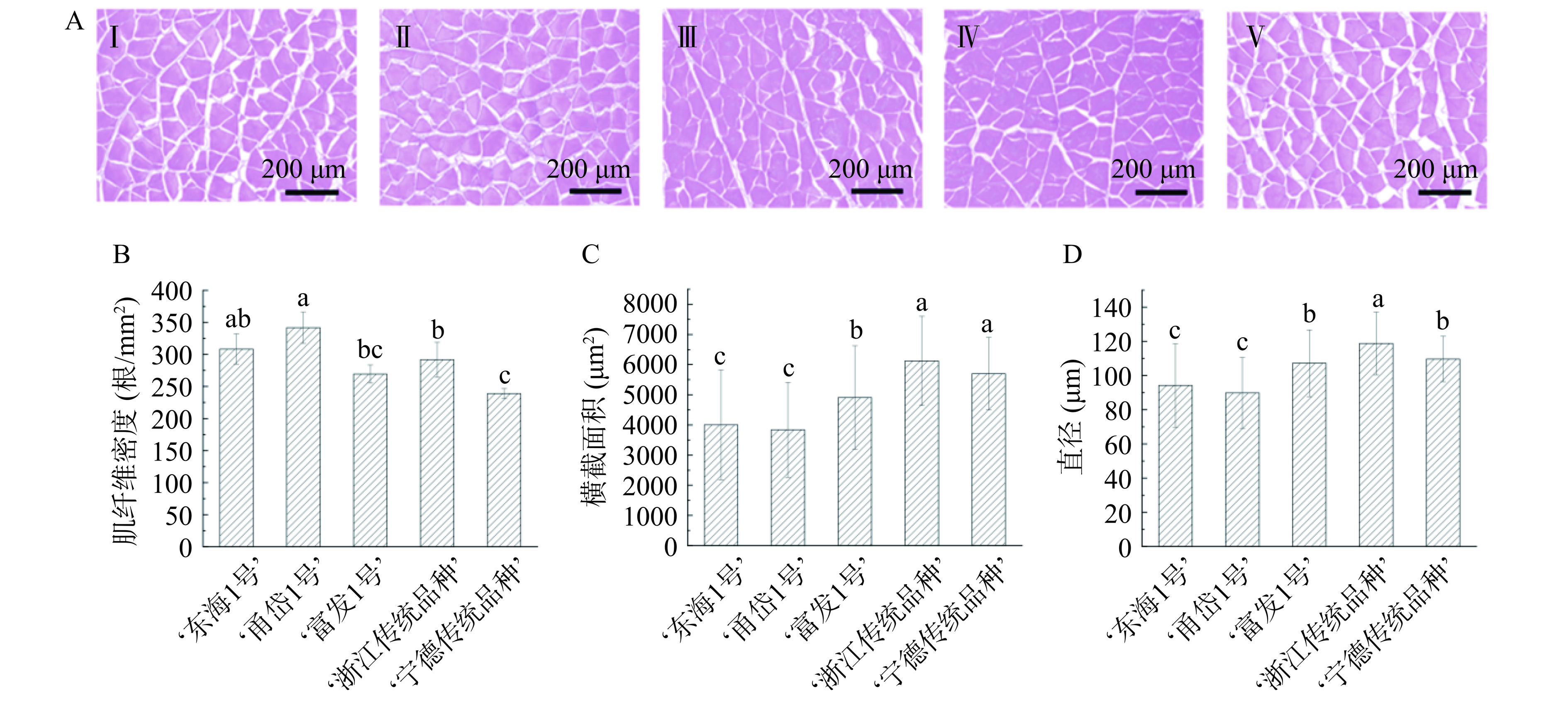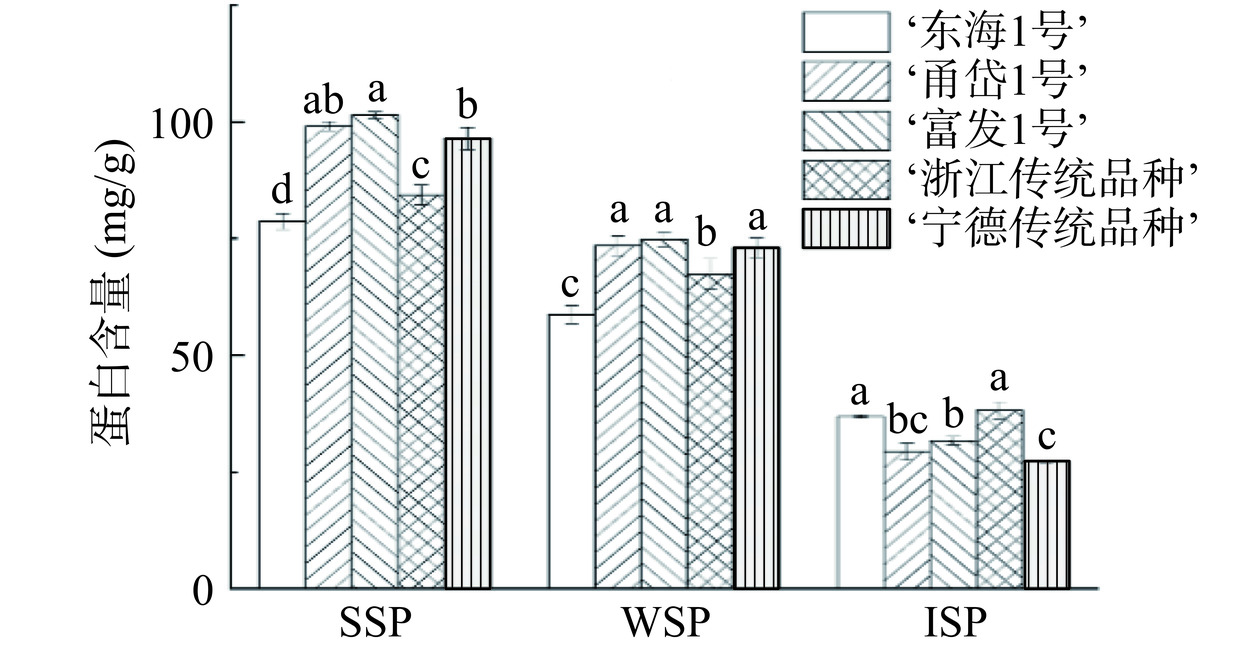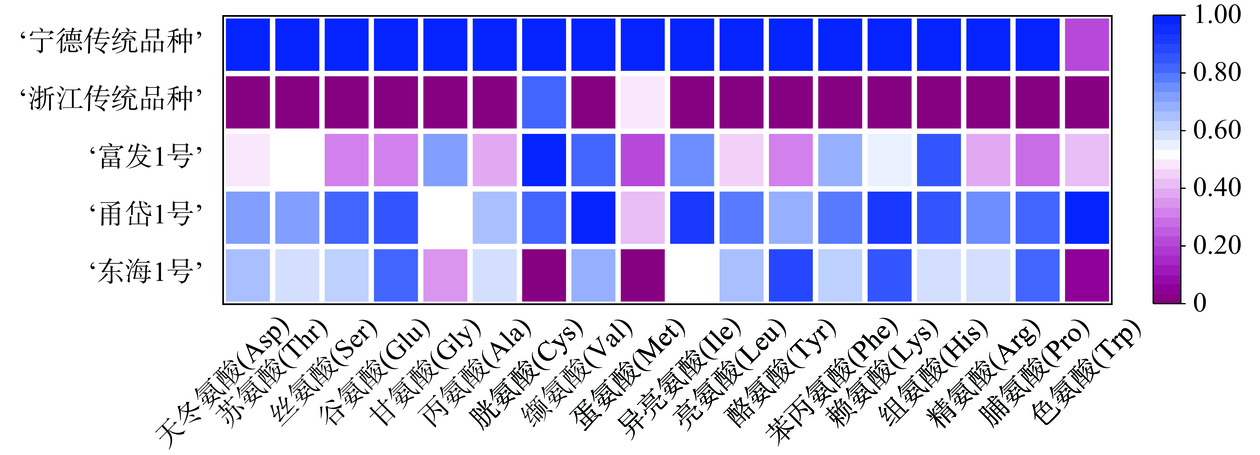Analysis of the Muscle Structure and Protein Composition of Different Varieties of Cultured Large Yellow Croaker (Larimichthys crocea)
-
摘要: 为探究不同品种养殖大黄鱼的食用品质差异,本研究以‘东海1号’‘甬岱1号’‘富发1号’‘浙江传统品种’及‘宁德传统品种’为对象,对其肌肉结构及蛋白组成进行测定分析。结果表明,不同品种大黄鱼的基本营养成分存在一定差异,‘富发1号’肌肉粗蛋白含量显著高于其他4个品种,而‘浙江传统品种’的粗脂肪含量最低,仅有2.77%;‘甬岱1号’大黄鱼肌纤维密度最高,是‘宁德传统品种’大黄鱼肌纤维密度的1.43倍;5个品种大黄鱼的肌纤维横截面积由大到小排序为‘浙江传统品种’>‘宁德传统品种’>‘富发1号’>‘东海1号’>‘甬岱1号’,低场核磁共振也发现‘甬岱1号’不易流动水具有较小的弛豫时间;‘富发1号’大黄鱼肌肉中盐溶性蛋白含量最高,为‘东海1号’的1.29倍,5个品种大黄鱼水溶性蛋白含量在58.72~74.85 mg/g之间,而凝胶电泳结果表明不同品种大黄鱼的肌肉蛋白分子量分布无显著差异;5个品种大黄鱼肌肉的亮氨酸、赖氨酸、苯丙氨酸和酪氨酸含量均高于WHO/FAO标准。本研究从食品原料学角度系统分析了不同品种养殖大黄鱼的肌肉结构及蛋白组成差异,为后续良种选育和高质加工提供参考。Abstract: To investigate the differences in edible quality among different varieties of cultured large yellow croaker, this study focused on 'Donghai 1' 'Yongdai 1' 'Fufa 1' 'traditional Zhejiang variety', and 'traditional Ningde variety', analyzing their muscle structure and protein composition. Results showed certain differences in the basic nutritional composition among the various varieties. The crude protein content in the muscle of 'Fufa 1' was significantly higher than that of the other four varieties, while the 'traditional Zhejiang variety' had the lowest crude fat content, at only 2.77%. The muscle fiber density of 'Yongdai 1' was the highest, being 1.43 times that of the 'traditional Ningde variety'. The cross-sectional area of the muscle fibers of the five varieties ranked from largest to smallest as follows: 'traditional Zhejiang variety'>'traditional Ningde variety'>'Fufa 1'>'Donghai 1'>'Yongdai 1'. Low-field NMR also revealed that the immobile water in 'Yongdai 1' had a shorter relaxation time. The salt-soluble protein content in the muscle of 'Fufa 1' was the highest, being 1.29 times that of 'Donghai 1'. The water-soluble protein content among the five varieties ranged from 58.72 mg/g to 74.85 mg/g, while the electrophoresis results showed no differences in the muscle protein molecular weight distribution across different varieties. The leucine, lysine, phenylalanine, and tyrosine contents in the muscles of all five varieties were higher than the WHO/FAO standards. This study systematically analyzed the differences in muscle structure and protein composition among different varieties of cultured large yellow croaker from the perspective of food material, providing a reference for subsequent variety selection and high-quality processing.
-
Keywords:
- cultured large yellow croaker /
- variety /
- protein composition /
- muscle structure /
- myofiber
-
大黄鱼(Larimichthys crocea)金鳞朱唇、营养丰富、味道鲜美,素有“国鱼”之美誉[1]。2022年我国养殖大黄鱼产量达25.77万吨,同比增长1.36%,产量持续居于我国海水养殖鱼类首位,其主要产地为福建、浙江和广东[2]。为了推进大黄鱼产业的高质量发展,国内诸多学者陆续开展了大黄鱼的良种选育研究,成功培育出了‘东海1号’‘甬岱1号’和‘富发1号’等优良品种,这些优良品种具有生长速率高、耐低温及体型好等诸多优良性状[3−5]。然而关于这些优良品种食用品质的研究却少见报道,没有很好地匹配目前消费终端日益增长的高品质需求。
肌肉是大黄鱼的主要可食部位,提供了优质蛋白、不饱和脂肪酸、矿物质和维生素等营养物质[6]。大黄鱼蛋白质含量约占肌肉干重的70%,是除水分外含量最多的营养物质[7]。肌纤维是肌肉基本组成单位,与肌肉的质构和持水性等食用品质密切相关[8−10]。郁二蒙等[11]研究发现,脆肉鲩背部白肌的肌纤维直径显著小于普通草鱼,且脆肉鲩背部白肌硬度显著高于普通草鱼,推测脆肉鲩肌肉的肌纤维特性与其肌肉硬度具有一定相关性。不同品种杂交肉羊[12]和肉鸡[13]在肌纤维密度和直径上也存在显著差异,并且与食用品质密切相关。蛋白质是肌肉组织主要成分,按其溶解性可分为盐溶性蛋白(Salt soluble protein,SSP)、水溶性蛋白(Water soluble protein,WSP)和难溶性蛋白(Insoluble protein,ISP)三类[14]。不同种类蛋白质的相对含量同样会对肌肉品质产生显著影响[15]。有研究报道,西伯利亚鲟、俄罗斯鲟等6个不同品种鲟鱼胶原蛋白含量差异显著[16]。总之,肌肉的组织结构和蛋白组成与品种密切相关,并且在很大程度上影响肌肉的食用品质。然而,不同品种大黄鱼的肌肉结构及蛋白组成尚未见报道。
本研究选取5种不同品种的养殖大黄鱼为研究对象,通过比较其基本营养成分、水分分布、肌纤维结构、蛋白组成、蛋白分子量分布及氨基酸组成,系统解析不同品种大黄鱼的肌肉结构及蛋白组成差异。本研究旨在从肌肉组织学角度比较不同品种大黄鱼的差异,并为选育高品质大黄鱼新品种提供参考。
1. 材料与方法
1.1 材料与仪器
‘东海1号’和‘浙江传统品种’大黄鱼 2023年10月下旬购入,浙江温州;‘甬岱1号’‘富发1号’和‘宁德传统品种’大黄鱼 2023年10月下旬购入,福建宁德;Carnoy固定液、Tris-HCl(pH7.5)、彩虹Marker 北京索莱宝科技有限公司;Tris-HCl(pH7.0) 生工生物工程(上海)股份有限公司;牛血清白蛋白 西格玛奥德里奇(上海)贸易有限公司;SDS-PAGE 蛋白上样缓冲液、考马斯亮蓝快速染液 上海碧云天生物技术有限公司。
NIKON ECLIPSE E100 正置光学显微镜 日本尼康公司;PQ001低场核磁共振分析仪 苏州纽迈分析仪器股份有限公司;FJ-200实验室高速分散均质机 上海沪析实业有限公司;Avanti J-301高性能离心机 美国Beckman Coulter公司;UV-3300紫外可见分光光度计 北京莱伯泰科仪器有限公司;L-8900 型氨基酸全自动分析仪 日本日立公司。
1.2 实验方法
1.2.1 原料处理
所有大黄鱼在捕捞后装入铺满碎冰的泡沫箱中,使其窒息致死,在4 ℃低温条件下24 h内运输至实验室,个体规格为(500±50 g)。将大黄鱼去皮、去内脏,分离大黄鱼背部肌肉作为实验材料。
1.2.2 基本营养成分
取适量大黄鱼背肌绞碎,进行基本营养成分测定,大黄鱼肌肉水分含量参照《食品安全国家标准 食品中水分的测定》(GB 5009.3-2016),采用直接干燥法测定;粗蛋白质含量参照《食品安全国家标准 食品中蛋白质的测定》(GB 5009.5-2016),采用凯氏定氮法测定;粗脂肪含量参照《食品安全国家标准 食品中脂肪的测定》(GB 5009.6-2016),采用索氏抽提法测定;灰分含量参照《食品安全国家标准 食品中灰分的测定》(GB 5009.4-2016),采用高温灼烧法测定。
1.2.3 低场核磁共振测定
参考Zhang等[17]的方法,稍作修改。将大黄鱼背部肌肉切成2 cm×2 cm×1 cm的小块,使用核磁共振成像仪进行水分分布测定。使用参数设定为:共振频率为22 MHz,90°脉宽为6.80 μs,采样频率为200 kHz,重复采样等待时间为2000 ms,累加次数为4,射频时间为200 μs,回波个数为6000,得到不同状态水分的顶峰弛豫时间(T2b、T21、T22、T23)。
1.2.4 肌纤维组织学观察
参考林佳丽等[18]的方法,稍作修改。取大黄鱼背肌肌肉切成0.5 cm×0.5 cm×1 cm的小块置于Carnoy固定液(60%无水乙醇、30%三氯甲烷和10%冰醋酸,v/v)内于4 ℃环境固定24 h以上。将肌肉从固定液取出修整,用脱水机内依次梯度酒精(75%、85%、95%和100%)进行脱水,浸蜡后放入包埋机内进行包埋,将包埋后的组织沿横向切成厚4 μm的切片,并用苏木素-伊红染液染色,使用光学显微镜观察肌纤维组织结构并采集图像,使用Image J软件进行统计。
1.2.5 肌肉蛋白含量测定
参考张龙[19]的方法,略加修改。所有操作均在4 ℃下进行,取适量大黄鱼背肌绞肉,将其转移到10倍体积的0.05 mol/L NaCl-20 mmol/L Tris-HCl(pH7.5)缓冲液中均质30 s,使用磁力搅拌器300 r/min搅拌30 min,使用高性能离心机在12000×g,10 min下进行离心,此过程重复2次,收集合并两次上清液。所得上清液即为水溶性蛋白组分(WSP)。在上述提取出的沉淀中加入10倍体积的0.6 mol/L NaCl-20 mmol/L Tris-HCl(pH7.5)缓冲液,搅拌30 min,静置30 min,离心(同上),重复操作3次,合并所有上清液。所得上清液作为盐溶性蛋白组分(SSP),所得沉淀为难溶性蛋白质组分(ISP)。
1.2.6 SDS-PAGE凝胶电泳
参考Zheng等[20]的方法,稍作修改。取适量大黄鱼背肌绞肉,加入6倍体积0.1 mol/L NaCl-20 mmol/L Tris-HCl(pH7.0)缓冲液,均质30 s,间隔后重复均质操作共3次,得全蛋白溶液。将全蛋白溶液及1.2.5中所得盐溶性蛋白溶液、水溶性蛋白溶液分别稀释至2 mg/mL,然后以4:1的比例加入电泳上样缓冲液,涡旋混合后于105 ℃加热6 min,得电泳样。使用12% SurePAGE预制胶,上样量20 μL,恒压200 V至电泳结束,用考马斯亮蓝快速染液染色后,多次用蒸馏水浸泡脱色至蛋白条带清晰。
1.2.7 氨基酸组成测定
肌肉中天冬氨酸、苏氨酸等17种氨基酸的测定参考《食品中氨基酸的测定》(GB 5009.124-2016)中酸水解方法进行。取0.1 g样品加入6 mol/L HCl溶液后充氮密封,在110 ℃条件下水解16 h,经定容、旋蒸、复溶、过滤后用氨基酸全自动分析仪进行检测。色氨酸的测定参考宋洁等[21]的方法,稍加修改。取0.1 g样品加入5 mol/L NaOH溶液后,充氮密封后置于110 ℃烘箱中水解20 h。经过滤、定容后,调节pH至7~8,再次定容、过膜后,上机进行检测。
1.2.8 氨基酸评价方法
不同品种大黄鱼肌肉氨基酸根据FAO/WHO建议的氨基酸评分标准模式计算氨基酸评分(AAS)和氨基酸的化学评分(CS)[22]。具体公式如下:
AAS=试样中某氨基酸含量(mg/g N)FAO/WHO标准模式中同种氨基酸含量(mg/g N) CS=试样中某氨基酸含量(mg/g N)鸡蛋蛋白模式中同种氨基酸含量(mg/g N) 1.3 数据处理
所有数据分析均采用 SPSS Statistics 25.0软件进行显著分析,采用单因素方差分析和Duncan氏多重比较检验进行显著性评价(P<0.05),实验结果表示为“平均值±标准差”(n=3)。全部图像由Origin 2024软件进行绘制。
2. 结果与分析
2.1 基本营养成分
不同品种大黄鱼肌肉的基本营养成分如表1所示,‘浙江传统品种’大黄鱼水分含量最高,为77.35%;‘富发1号’大黄鱼的肌肉粗蛋白含量显著高于其余4个品种(P<0.05);‘浙江传统品种’大黄鱼肌肉的粗脂肪含量最低,仅有2.77%,5种大黄鱼在灰分含量差异较小。相似结果在不同品种罗非鱼中也有报道,新吉富罗非鱼的水分及粗灰分含量高,而奥利亚罗非鱼的粗蛋白质和粗脂肪含量分别为21%及2.35%显著高于其他两个品种[23]。5个品种大黄鱼粗蛋白含量(16.02%~18.99%)均高于鸡蛋(12.8%)[24],是良好的动物蛋白摄入源。
表 1 不同品种养殖大黄鱼的基本营养成分Table 1. Basic nutritional components of different varieties of cultured large yellow croaker指标 ‘东海1号’ ‘甬岱1号’ ‘富发1号’ ‘浙江传统品种’ ‘宁德传统品种’ 水分(%) 76.01±0.29b 77.03±0.19a 68.37±0.21d 77.35±0.33a 73.89±0.33c 粗蛋白(%) 17.34±0.29c 17.80±0.19bc 18.99±0.17a 16.02±0.05d 18.12±0.41b 粗脂肪(%) 3.85±0.09c 4.46±0.15b 6.47±0.23a 2.77±0.43d 6.71±0.12a 灰分(%) 1.17±0.03bc 1.18±0.02abc 1.22±0.01a 1.15±0.02b 1.21±0.02ab 注:不同小写英文字母表示同行数据差异显著,P<0.05。 2.2 水分分布
低场核磁共振技术(Low-field nuclear magnetic resonance,LF-NMR)广泛应用于食品水分分布、水分迁移等的研究[25]。如图1a所示,T2值位于0.01~10 ms之间的两个峰为结合水,与蛋白质结合紧密,其中T2值较小的峰为强结合水,T2值较大的为弱结合水,分别用T2b、T21表示;位于10~100 ms之间的峰(T22)为不易流动水,存在于肌纤维蛋白基质内部;在T2>1000 ms的峰(T23)为自由水[26]。‘甬岱1号’大黄鱼T22最小,为46.79 ms,说明该品种鱼肉不易流动水与组织结合紧密,流动性较低。有研究发现,鱼肉中不易流动水流动性低,表明其肌肉的持水力好[27]。
不同T2区间的峰面积表示各运动状态氢相对量,图1b中P2b、P21、P22、P23分别为T2b、T21、T22、T23所对应峰的面积占峰面积总和的比例。5个品种大黄鱼肌肉中91.28%~95.15%的水分为不易流动水,为总水分主体。这与Li等[28]所得结果一致,即不易流动水作为存在于肌纤维蛋白基质内部的水分,占肉类总水分的90%以上。5个品种大黄鱼强结合水及弱结合水占比无显著差异(P>0.05),‘宁德传统品种’的不易流动水占比最高,达95.15%,‘富发1号’最低,两者相差3.87%,‘富发1号’的自由水比例显著高于其余4个品种(P<0.05),为5.08%,是‘东海1号’的6.35倍。
2.3 肌肉显微结构
肌纤维是构成鱼体肌肉组织的基本单位,肌纤维的组成结构特性是肌肉结构的决定性因素,肌纤维特性常被作为肉品质量的重要指标[29]。图2A图像为5种养殖大黄鱼肌肉组织微观结构,可看出各个品种大黄鱼的肌纤维边界清晰,染色均匀,能观察到不同品种大黄鱼肌纤维的大小、数量及它们之间的空隙大小。‘宁德传统品种’肌纤维空隙较大,肌纤维排列松散,而‘浙江传统品种’肌肉肌纤维之间的间隙小,且肌纤维细胞横截面积较大。通过组织切片观察发现不同品种的养殖大黄鱼肌纤维结构存在一定差异,进一步通过Image J软件计算肌肉肌纤维密度、横截面积及直径。
![]() 图 2 不同品种养殖大黄鱼肌肉组织微观结构(A)、肌纤维密度(B)、横截面积(C)和直径(D)注:Ⅰ:‘东海1号’;Ⅱ:‘甬岱1号’;Ⅲ:‘富发1号’;Ⅳ:‘浙江传统品种’;Ⅴ:‘宁德传统品种’;不同小写字母表示不同品种之间的统计具有显著差异(P<0.05);图3同。Figure 2. Microscopic structure (A), muscle fiber density (B), cross-sectional area (C), and diameter (D) of muscle tissue of different varieties of cultured large yellow croaker
图 2 不同品种养殖大黄鱼肌肉组织微观结构(A)、肌纤维密度(B)、横截面积(C)和直径(D)注:Ⅰ:‘东海1号’;Ⅱ:‘甬岱1号’;Ⅲ:‘富发1号’;Ⅳ:‘浙江传统品种’;Ⅴ:‘宁德传统品种’;不同小写字母表示不同品种之间的统计具有显著差异(P<0.05);图3同。Figure 2. Microscopic structure (A), muscle fiber density (B), cross-sectional area (C), and diameter (D) of muscle tissue of different varieties of cultured large yellow croaker不同品种大黄鱼肌纤维密度如图2B所示,‘甬岱1号’大黄鱼肌纤维密度最高,为341.67根/mm2,其次为‘东海1号’大黄鱼达308.33根/mm2,‘宁德传统品种’大黄鱼肌纤维密度最小,为238.89根/mm2。‘甬岱1号’不易流动水弛豫时间最小,推测高肌纤维密度可以更好地保持肌肉水分。5个品种大黄鱼的肌纤维横截面积和直径如图2C~图2D,其结果由大到小依次为:‘浙江传统品种’>‘宁德传统品种’>‘富发1号’>‘东海1号’>‘甬岱1号’,其中‘浙江传统品种’肌纤维横截面积为6125.01 μm2,直径为118.76 μm,‘甬岱1号’肌纤维横截面积及直径分别3837.1 μm2和89.85 μm。其排列与肌纤维密度结果基本呈负相关,这与林婉玲等[30]在草鱼的研究中发现类似,即肌纤维直径越小,其数量就增多,肌纤维直径与密度呈显著负相关。在对不同品种鸡肉品质差异系列研究中发现,不同品种的鸡肉肌纤维密度、肌纤维直径存在显著差异(P<0.05),且肌纤维直径与鸡肉剪切力呈正相关,与肌纤维密度呈负相关[31] ,且肌纤维直径大小与原料鸡的体重无关,与品种、肌肉部位相关[32]。肌肉肌纤维的类型、直径和密度等与其基因表达有直接关系[33−34],后续研究可进一步分析不同品种大黄鱼中影响肌纤维中肌细胞表达的关键基因。
2.4 蛋白组成
肌肉中的三类蛋白(盐溶性蛋白、水溶性蛋白、难溶性蛋白)在肉品感官和质构特性等品质指标中起决定性作用[35]。不同品种养殖大黄鱼肌肉蛋白组成如图3所示,所有大黄鱼肌肉中不同蛋白质的含量均为盐溶性蛋白>水溶性蛋白>难溶性蛋白,其中盐溶性占大黄鱼总蛋白44.40%~49.05%,水溶性蛋白占33.69%~37.15%,难溶性蛋白占13.83%~21.19%。‘富发1号’大黄鱼盐溶性蛋白含量最高为101.47 mg/g,是含量最低的‘东海1号’大黄鱼的1.29倍。盐溶性蛋白主要由肌球蛋白和肌动蛋白等构成,约占肌肉总蛋白中的40~60%,是动物肌肉中最重要的蛋白质[36]。大黄鱼水溶性蛋白含量在58.72~74.85 mg/g之间,‘甬岱1号’‘富发1号’‘宁德传统品种’大黄鱼的水溶性蛋白含量无显著差异(P>0.05)。水溶性蛋白主要由肌红蛋白及酶类构成,主要是糖酵解酶系,还有磷酸戊糖途径酶系和肌酸激酶、AMP-脱氨酶等[19],主要与肉品呈味和色泽有关。‘浙江传统品种’和‘东海1号’难溶性蛋白含量显著高于其余3个品种,‘宁德传统品种’最低。难溶性蛋白包括胶原蛋白和弹性蛋白,是肌肉结缔组织的主要成分,与肉品嫩度指标等密切相关[35]。有研究得出,肌肉蛋白组成与其基因、基因表达量等因素直接相关[37],推测大黄鱼品种差异导致基因表达不同,影响大黄鱼肌肉蛋白组成。
2.5 蛋白分子量分布
在了解不同品种养殖大黄鱼肌肉蛋白组成的基础上,进一步对其蛋白分子量分布差异进行分析。图4A~图4C分别为5种大黄鱼肌肉全蛋白、盐溶性蛋白和水溶性蛋白电泳图谱,5种大黄鱼蛋白分子量均主要分布于>135 kDa及35~48 kDa区间内,其中200 kDa 以上分子量的蛋白分布多,推测五种大黄鱼肌肉中含大量肌球蛋白重链(220 kDa),肌球蛋白重链是肌球蛋白的基本组成单位,与水产品肌肉品质特征关系密切[38] 。所有大黄鱼电泳图谱在35~48 kDa 范围内均有多个条带,推测为肌动蛋白(45 kDa)及原肌球蛋白(36 kDa),25 kDa下方多个条带为肌球蛋白轻链(24、17、15 kDa)。肌球蛋白和肌动蛋白约占总肌丝蛋白质的65%,在维持肌肉结构方面起重要作用[39]。综上,凝胶电泳结果表明不同品种大黄鱼的肌肉蛋白分子量分布无显著差异,后续研究可借助质谱手段进行深入分析。
![]() 图 4 不同品种养殖大黄鱼全蛋白电泳图谱(A)、盐溶性蛋白电泳图谱(B)和水溶性蛋白电泳图谱(C)注:M:标准蛋白;1:‘东海1号’;2:‘甬岱1号’;3:‘富发1号’;4:‘浙江传统品种’;5:‘宁德传统品种’。Figure 4. Whole protein SDS-PAGE patterns (A), salt soluble protein SDS-PAGE patterns (B), and water soluble protein SDS-PAGE patterns (C) of different varieties of cultured large yellow croaker
图 4 不同品种养殖大黄鱼全蛋白电泳图谱(A)、盐溶性蛋白电泳图谱(B)和水溶性蛋白电泳图谱(C)注:M:标准蛋白;1:‘东海1号’;2:‘甬岱1号’;3:‘富发1号’;4:‘浙江传统品种’;5:‘宁德传统品种’。Figure 4. Whole protein SDS-PAGE patterns (A), salt soluble protein SDS-PAGE patterns (B), and water soluble protein SDS-PAGE patterns (C) of different varieties of cultured large yellow croaker2.6 氨基酸组成及评价
氨基酸是蛋白质的构建分子,不同品种养殖大黄鱼肌肉蛋白的氨基酸组成如图5和表2所示。在所有品种大黄鱼肌肉中均检测出天冬氨酸、苏氨酸等18种氨基酸。其中,谷氨酸占所有品种大黄鱼氨基酸含量首位,为2.62%~3.06%,而胱氨酸含量均占最低为0.05%~0.10%。5个品种大黄鱼肌肉中,肌肉必需氨基酸与总氨基酸之比(EAA/TAA)为35.59%~36.72%,‘甬岱1号’的必需氨基酸含量最高,必需氨基酸与非必需氨基酸之比(EAA/NEAA)为55.25%~58.03%。
表 2 不同品种养殖大黄鱼必需氨基酸的营养评价Table 2. Evaluation of essential amino acid nutrition of different varieties of cultured large yellow croaker品种 项目 异亮氨酸
(Ile)亮氨酸
(Leu)赖氨酸
(Lys)苏氨酸
(Thr)缬氨酸
(Val)蛋氨酸+胱氨酸
(Met+Cys)苯丙氨酸+酪氨酸
(Phe+Tyr)EAA ‘东海1号’ AAS 0.67 1.12 1.67 1.10 0.93 0.69 1.26 1.05 CS 0.49 0.91 1.31 0.93 0.71 0.42 0.81 0.77 ‘甬岱1号’ AAS 0.72 1.14 1.68 1.12 0.99 0.84 1.27 1.12 CS 0.53 0.93 1.32 0.95 0.75 0.52 0.82 0.83 ‘富发1号’ AAS 0.70 1.09 1.58 1.09 0.96 0.80 1.22 1.05 CS 0.51 0.88 1.24 0.93 0.73 0.49 0.79 0.78 ‘浙江传统品种’ AAS 0.58 1.00 1.42 0.98 0.81 0.85 1.09 0.93 CS 0.43 0.81 1.12 0.83 0.61 0.52 0.70 0.69 ‘宁德传统品种’ AAS 0.74 1.18 1.71 1.19 0.99 0.98 1.33 1.13 CS 0.55 0.96 1.34 1.01 0.75 0.60 0.86 0.84 氨基酸评分(AAS)和化学评分(CS)是食品营养价值评价中常用评分方法之一,AAS和CS越接近1,说明营养价值越高越容易被人体吸收,且评分最低的则为第一限制性氨基酸[40]。不同品种养殖大黄鱼必需氨基酸营养价值评价结果如表2显示,5个品种大黄鱼肌肉的亮氨酸、赖氨酸、苯丙氨酸和酪氨酸含量以及除‘浙江传统品种’的苏氨酸含量均高于WHO/FAO标准,其余氨基酸含量低于WHO/FAO标准。除‘浙江传统品种’外的大黄鱼其必需氨基酸含量均高于WHO/FAO标准。而根据CS评分看,5个品种的大黄鱼赖氨酸含量均高于鸡蛋蛋白,可用于以谷物为主的膳食赖氨酸的不足[40]。
3. 结论
本研究通过分析5种不同品种养殖大黄鱼的基本营养成分、水分分布、肌肉组织结构、蛋白组成、蛋白分子量分布及氨基酸组成的差异发现,5个品种大黄鱼中,‘浙江传统品种’大黄鱼水分含量最高,粗脂肪含量最低,‘富发1号’粗蛋白含量最高。不同品种大黄鱼强结合水和弱结合水含量差异不显著,‘宁德传统品种’的不易流动水占比最高,‘富发1号’最低,分别为95.15%、91.28%,‘富发1号’的自由水占比显著高于其余品种,是占比最低的‘东海1号’的6.35倍;‘甬岱1号’大黄鱼肌纤维密度最高,为341.67根/mm2,其次为‘东海1号’大黄鱼308.33根/mm2,‘宁德传统品种’大黄鱼肌纤维密度最小,5个品种大黄鱼的肌纤维横截面积和直径与肌纤维密度基本呈负相关;5个品种中,‘富发1号’大黄鱼的盐溶性蛋白含量最高,为49.05%,是‘东海1号’大黄鱼的1.29倍,大黄鱼水溶性蛋白含量在58.72~74.85 mg/g之间,5种大黄鱼难溶性蛋白含量由高到低依次为‘浙江传统品种’‘东海1号’‘富发1号’‘甬岱1号’‘宁德传统品种’;5个品种大黄鱼中‘甬岱1号’必需氨基酸含量最高,达36.72%,5个品种大黄鱼肌肉的亮氨酸、赖氨酸、苯丙氨酸和酪氨酸含量均高于WHO/FAO标准,赖氨酸含量均高于鸡蛋蛋白。综上,不同品种养殖大黄鱼在选育过程中存在的遗传差异,可能影响了蛋白质的表达和翻译,进一步使其蛋白组成和肌肉结构发生变化,最终影响其食用品质。后续研究将通过蛋白组学技术进一步分析不同品种间的差异蛋白,并结合高通量测序方法寻找关键基因,从食用角度为良种选育提供参考。
-
图 2 不同品种养殖大黄鱼肌肉组织微观结构(A)、肌纤维密度(B)、横截面积(C)和直径(D)
注:Ⅰ:‘东海1号’;Ⅱ:‘甬岱1号’;Ⅲ:‘富发1号’;Ⅳ:‘浙江传统品种’;Ⅴ:‘宁德传统品种’;不同小写字母表示不同品种之间的统计具有显著差异(P<0.05);图3同。
Figure 2. Microscopic structure (A), muscle fiber density (B), cross-sectional area (C), and diameter (D) of muscle tissue of different varieties of cultured large yellow croaker
图 4 不同品种养殖大黄鱼全蛋白电泳图谱(A)、盐溶性蛋白电泳图谱(B)和水溶性蛋白电泳图谱(C)
注:M:标准蛋白;1:‘东海1号’;2:‘甬岱1号’;3:‘富发1号’;4:‘浙江传统品种’;5:‘宁德传统品种’。
Figure 4. Whole protein SDS-PAGE patterns (A), salt soluble protein SDS-PAGE patterns (B), and water soluble protein SDS-PAGE patterns (C) of different varieties of cultured large yellow croaker
表 1 不同品种养殖大黄鱼的基本营养成分
Table 1 Basic nutritional components of different varieties of cultured large yellow croaker
指标 ‘东海1号’ ‘甬岱1号’ ‘富发1号’ ‘浙江传统品种’ ‘宁德传统品种’ 水分(%) 76.01±0.29b 77.03±0.19a 68.37±0.21d 77.35±0.33a 73.89±0.33c 粗蛋白(%) 17.34±0.29c 17.80±0.19bc 18.99±0.17a 16.02±0.05d 18.12±0.41b 粗脂肪(%) 3.85±0.09c 4.46±0.15b 6.47±0.23a 2.77±0.43d 6.71±0.12a 灰分(%) 1.17±0.03bc 1.18±0.02abc 1.22±0.01a 1.15±0.02b 1.21±0.02ab 注:不同小写英文字母表示同行数据差异显著,P<0.05。 表 2 不同品种养殖大黄鱼必需氨基酸的营养评价
Table 2 Evaluation of essential amino acid nutrition of different varieties of cultured large yellow croaker
品种 项目 异亮氨酸
(Ile)亮氨酸
(Leu)赖氨酸
(Lys)苏氨酸
(Thr)缬氨酸
(Val)蛋氨酸+胱氨酸
(Met+Cys)苯丙氨酸+酪氨酸
(Phe+Tyr)EAA ‘东海1号’ AAS 0.67 1.12 1.67 1.10 0.93 0.69 1.26 1.05 CS 0.49 0.91 1.31 0.93 0.71 0.42 0.81 0.77 ‘甬岱1号’ AAS 0.72 1.14 1.68 1.12 0.99 0.84 1.27 1.12 CS 0.53 0.93 1.32 0.95 0.75 0.52 0.82 0.83 ‘富发1号’ AAS 0.70 1.09 1.58 1.09 0.96 0.80 1.22 1.05 CS 0.51 0.88 1.24 0.93 0.73 0.49 0.79 0.78 ‘浙江传统品种’ AAS 0.58 1.00 1.42 0.98 0.81 0.85 1.09 0.93 CS 0.43 0.81 1.12 0.83 0.61 0.52 0.70 0.69 ‘宁德传统品种’ AAS 0.74 1.18 1.71 1.19 0.99 0.98 1.33 1.13 CS 0.55 0.96 1.34 1.01 0.75 0.60 0.86 0.84 -
[1] 段青源, 钟惠英, 斯列钢, 等. 网箱养殖大黄鱼与天然大黄鱼营养成分的比较分析[J]. 浙江海洋学院学报(自然科学版),2000(2):125−128. [DUAN Q Y, ZHONG H Y, SI L G, et al. Comparative analyses of biochemical composition in net cultured and wild Pseudosciaena crocea (Richardson)[J]. Journal of Zhejiang Ocean University (Natural Science ),2000(2):125−128.] DUAN Q Y, ZHONG H Y, SI L G, et al. Comparative analyses of biochemical composition in net cultured and wild Pseudosciaena crocea (Richardson)[J]. Journal of Zhejiang Ocean University (Natural Science ), 2000(2): 125−128.
[2] 农业农村部渔业渔政管理局. 2023年中国渔业统计年鉴[M]. 北京:中国农业出版社, 2023:22−26. [Fishery Administration Bureau of Ministry of Agriculture and Rural Affairs. 2023 China fisheries statistics yearbook[M]. Beijing:China Agricultural Press, 2023:22−26.] Fishery Administration Bureau of Ministry of Agriculture and Rural Affairs. 2023 China fisheries statistics yearbook[M]. Beijing: China Agricultural Press, 2023: 22−26.
[3] 李伟业, 罗海忠, 殷小龙, 等. 低温胁迫对耐低温和非耐低温品系大黄鱼MT、AQP1、TCP1基因表达的影响[J]. 大连海洋大学学报,2021,36(1):38−43. [LI W Y, LUO H Z, YIN X L, et al. Effects of low temperature stress on MT, AQP1, and TCP1 gene expression in large yellow croaker of low temperature tolerance and non-tolerance lines[J]. Journal of Dalian Ocean University,2021,36(1):38−43.] LI W Y, LUO H Z, YIN X L, et al. Effects of low temperature stress on MT, AQP1, and TCP1 gene expression in large yellow croaker of low temperature tolerance and non-tolerance lines[J]. Journal of Dalian Ocean University, 2021, 36(1): 38−43.
[4] 陈宏霖, 徐承旭. 抗白点病大黄鱼选育有新进展[J]. 水产科技情报,2019,46(5):299. [CHEN H L, XU C X. New progress has been made in breeding large yellow croaker resistant to white spot disease[J]. Fisheries Science and Technology Information,2019,46(5):299.] CHEN H L, XU C X. New progress has been made in breeding large yellow croaker resistant to white spot disease[J]. Fisheries Science and Technology Information, 2019, 46(5): 299.
[5] ZHOU M, YUAN Y B, ZHANG Y J, et al. The study of the genomic selection of white gill disease resistance in large yellow croaker (Larimichthys crocea)[J]. Aquaculture,2023,574:739682. doi: 10.1016/j.aquaculture.2023.739682
[6] PRUDOVSKY I, BAGALA C, TARANTINI F, et al. The intracellular translocation of the components of the fibroblast growth factor 1 release complex precedes their assembly prior to export[J]. Journal of Cell Biology,2002,158(2):201−208. doi: 10.1083/jcb.200203084
[7] 侯思禹. 花鲈肌肉营养特征分析[D]. 天津:天津农学院, 2023. [HOU S Y. Analysis on nutritional characteristics of lateolabrax maculatus[D]. Tianjin:Tianjin Agricultural University, 2023.] HOU S Y. Analysis on nutritional characteristics of lateolabrax maculatus[D]. Tianjin: Tianjin Agricultural University, 2023.
[8] HURLING R, RODELL J B, HUNT H D. Research note:fiber diameter and fish texture[J]. Journal of Texture Studies,1996,27(6):679−685. doi: 10.1111/j.1745-4603.1996.tb01001.x
[9] FAUCONNEAU B, CHMAITILLY J, ANDRE S, et al. Characteristics of rainbow trout flesh:I. Chemical composition and cellularity of muscle and adipose tissues[J]. Sciences des Aliments,1993,13:173−187.
[10] HATAE K, YOSHIMATSU F, MATSUMOTO J J. Role of muscle fibers in contributing firmness of cooked fish[J]. Journal of Food Science,2006,55(3):693−696.
[11] 郁二蒙, 谢骏, 卢炳国, 等. 脆肉鲩与普通草鱼肌肉显微结构观察[J]. 南方农业学报,2014,45(4):671−675. [YU E M, XIE J, LU B G, et al. Microstructure of muscles between crisp grass carp and common grass carp[J]. Journal of Southern Agriculture,2014,45(4):671−675.] YU E M, XIE J, LU B G, et al. Microstructure of muscles between crisp grass carp and common grass carp[J]. Journal of Southern Agriculture, 2014, 45(4): 671−675.
[12] 李旺平, 王建军, 严秉莲, 等. 不同品种杂交肉羊生产性能和肉品质的比较[J]. 中国畜牧杂志,2019,55(5):118−123. [LI W P, WANG J J, YAN B L, et al. Comparison of performance and meat quality of crossbred mutton sheep of different breeds[J]. Chinese Journal of Animal Science,2019,55(5):118−123.] LI W P, WANG J J, YAN B L, et al. Comparison of performance and meat quality of crossbred mutton sheep of different breeds[J]. Chinese Journal of Animal Science, 2019, 55(5): 118−123.
[13] 李威娜, 黄勋和, 陈洁波, 等. 五华三黄鸡及不同品种鸡肌纤维特性与肉品质的相关性[J]. 江苏农业科学,2017,45(2):157−160. [LI W N, HUANG X H, CHEN J B, et al. Correlation between muscle fiber characteristics and meat quality of Wuhua Sanhuang chickens and different breeds[J]. Jiangsu Agricultural Sciences,2017,45(2):157−160.] LI W N, HUANG X H, CHEN J B, et al. Correlation between muscle fiber characteristics and meat quality of Wuhua Sanhuang chickens and different breeds[J]. Jiangsu Agricultural Sciences, 2017, 45(2): 157−160.
[14] ZHU Y L, BAO M, CHEN C, et al. Comparison of the nutritional composition of bullfrog meat from different parts of the animal[J]. Food Science of Animal Resources,2021,41(6):1049−1059. doi: 10.5851/kosfa.2021.e56
[15] 尹蕾丽, 周纷, 姚林燕, 等. 皱纹盘鲍(Haliotis discus hannai)不同部位肌肉的蛋白分布特性[J]. 食品工业科技,2020,41(21):93−98. [YIN L L, ZHOU F, YAO L Y, et al. Characteristics of protein distribution in different muscles of Haliotis discus hannai[J]. Science and Technology of Food Industry,2020,41(21):93−98.] YIN L L, ZHOU F, YAO L Y, et al. Characteristics of protein distribution in different muscles of Haliotis discus hannai[J]. Science and Technology of Food Industry, 2020, 41(21): 93−98.
[16] 陈泽凡, 刘天红, 韩贵新, 等. 6种鲟鱼鱼皮营养评价与组织学分析[J]. 水产科学,2022,41(6):938−948. [CHEN Z F, LIU T H, HAN G X, et al. Nutritional evaluation and histological analysis of the skin of six sturgeon species[J]. Fisheries Science,2022,41(6):938−948.] CHEN Z F, LIU T H, HAN G X, et al. Nutritional evaluation and histological analysis of the skin of six sturgeon species[J]. Fisheries Science, 2022, 41(6): 938−948.
[17] ZHANG L, YIN M Y, WANG X C. Meat texture, muscle histochemistry and protein composition of Eriocheir sinensis with different size traits[J]. Food Chemistry, 2021, 338:127632.
[18] 林佳丽. 温度对斑马鱼肌肉营养组成和胶原蛋白含量的影响及初步机制研究[D]. 汕头:汕头大学, 2021. [LIN J L. Preliminary study on the effects of temperature on muscle nutritional composition and collagen content of zebrafish (Danio rerio)[D]. Shantou:Shantou University, 2021.] LIN J L. Preliminary study on the effects of temperature on muscle nutritional composition and collagen content of zebrafish (Danio rerio)[D]. Shantou: Shantou University, 2021.
[19] 张龙. 菲律宾蛤仔(Ruditapes philippinarum)的蛋白分布特性[D]. 大连:大连海洋大学, 2016. [ZHANG L, The distribution profiles of muscle protein from Ruditapes philippinarum[D]. Dalian:Dalian Ocean University, 2016.] ZHANG L, The distribution profiles of muscle protein from Ruditapes philippinarum[D]. Dalian: Dalian Ocean University, 2016.
[20] ZHENG Y, ZHOU F, ZHANG L, et al. Effect of different extent of protein oxidation on the frozen storage stability of muscle protein in obscure pufferfish (Takifugu obscurus)[J]. LWT,2021,137:110416. doi: 10.1016/j.lwt.2020.110416
[21] 宋洁, 王丽芳, 姚一萍, 等. 微波水解—氨基酸自动分析仪法测定饲料中色氨酸的含量[J]. 畜牧与饲料科学,2021,42(2):19−25. [SONG J, WANG L F, YAO Y P, et al. Determination of tryptophan in feed by microwave hydrolysis and amino acid automatic analyzer[J]. Animal Husbandry and Feed Science,2021,42(2):19−25.] SONG J, WANG L F, YAO Y P, et al. Determination of tryptophan in feed by microwave hydrolysis and amino acid automatic analyzer[J]. Animal Husbandry and Feed Science, 2021, 42(2): 19−25.
[22] YIN L Q, XU M X, HUANG Q K, et al. Nutrition and flavor evaluation of amino acids in Guangyuan grey chicken of different ages, genders and meat cuts.[J]. Animals,2023,13(7):1235. doi: 10.3390/ani13071235
[23] 连晨阳, 秦志清, 陈志, 等. 3种罗非鱼肌肉营养成分比较与评价[J]. 水产养殖,2022,43(4):17−22. [LIAN C Y, QIN Z Q, CHEN Z, et al. Comparative evaluation of muscle nutritional components of three tilapia species[J]. Journal of Aquaculture,2022,43(4):17−22.] LIAN C Y, QIN Z Q, CHEN Z, et al. Comparative evaluation of muscle nutritional components of three tilapia species[J]. Journal of Aquaculture, 2022, 43(4): 17−22.
[24] 曾莉婷, 骆轩, 柯才焕, 等. 不同鲍及其杂交种的营养成分与质构特性[J]. 水产学报,2023,47(1):227−238. [ZENG L T, LUO X, KE C H, et al. Nutritional components and texture profiles of different abalone species and their hybrids[J]. Journal of Fisheries of China,2023,47(1):227−238.] ZENG L T, LUO X, KE C H, et al. Nutritional components and texture profiles of different abalone species and their hybrids[J]. Journal of Fisheries of China, 2023, 47(1): 227−238.
[25] 杨文鸽, 张问, 王小飞, 等. 用低场核磁共振研究盐溶液漂洗对带鱼鱼糜凝胶品质的影响[J]. 农业工程学报,2016,32(7):263−269. [YANG W G, ZHANG W, WANG X F, et al. Effect of salt solution rinse on properties of hairtail surimi gel by low-field nuclear magnetic resonance[J]. Transactions of the Chinese Society of Agricultural Engineering (Transactions of the CSAE),2016,32(7):263−269.] doi: 10.11975/j.issn.1002-6819.2016.07.037 YANG W G, ZHANG W, WANG X F, et al. Effect of salt solution rinse on properties of hairtail surimi gel by low-field nuclear magnetic resonance[J]. Transactions of the Chinese Society of Agricultural Engineering (Transactions of the CSAE), 2016, 32(7): 263−269. doi: 10.11975/j.issn.1002-6819.2016.07.037
[26] 李秀, 王永瑞, 刘思佳, 等. 基于LF-NMR和HS-SPME-GC-MS研究煮制羊皮中水分分布及关键挥发性风味物质[J]. 食品与发酵工业,2023,49(11):273−279. [LI X, WANG Y R, LIU S J, et al. Effect of roasting time on the moisture distribution and key volatile flavor compounds of beef tallow as analyzed by low field-nuclear magnetic resonance spectroscopy and headspace solid-phase microextraction coupled with gas chromatography-mass spectrometry[J]. Food and Fermentation Industries,2023,49(11):273−279.] LI X, WANG Y R, LIU S J, et al. Effect of roasting time on the moisture distribution and key volatile flavor compounds of beef tallow as analyzed by low field-nuclear magnetic resonance spectroscopy and headspace solid-phase microextraction coupled with gas chromatography-mass spectrometry[J]. Food and Fermentation Industries, 2023, 49(11): 273−279.
[27] 张楠楠, 蓝蔚青, 黄夏, 等. 迷迭香复配液对大黄鱼冰藏品质及水分迁移的影响[J]. 食品科学,2019,40(7):247−253. [ZHANG N N, LAN W Q, HUANG X, et al. Effect of rosemary extract and ε-Polylysine blend on the quality and moisture migration of large yellow croaker during ice storage[J]. Food Science,2019,40(7):247−253.] ZHANG N N, LAN W Q, HUANG X, et al. Effect of rosemary extract and ε-Polylysine blend on the quality and moisture migration of large yellow croaker during ice storage[J]. Food Science, 2019, 40(7): 247−253.
[28] LI W M, WANG P, XU X L, et al. Use of low-field nuclear magnetic resonance to characterize water properties in frozen chicken breasts thawed under high pressure[J]. European Food Research and Technology,2014,239(2):183−188. doi: 10.1007/s00217-014-2189-9
[29] 卢金河, 桂蕴, 房灿, 等. 不同品种鸡肉品质的分析[J]. 今日畜牧兽医,2023,39(6):78−80. [LU J H, GUI Y, FANG C, et al. Analysis of the quality of different chicken breeds[J]. Today Animal Husbandry and Veterinary Medicine,2023,39(6):78−80.] LU J H, GUI Y, FANG C, et al. Analysis of the quality of different chicken breeds[J]. Today Animal Husbandry and Veterinary Medicine, 2023, 39(6): 78−80.
[30] 林婉玲, 关熔, 曾庆孝, 等. 影响脆肉鲩鱼背肌质构特性的因素[J]. 华南理工大学学报(自然科学版),2009,37(4):134−137. [LIN W L, GUAN R, ZENG Q X, et al. Factors affecting textural characteristics of dorsal muscle of crisp grass carp[J]. Journal of South China University of Technology (Natural Science Edition),2009,37(4):134−137.] LIN W L, GUAN R, ZENG Q X, et al. Factors affecting textural characteristics of dorsal muscle of crisp grass carp[J]. Journal of South China University of Technology (Natural Science Edition), 2009, 37(4): 134−137.
[31] 赵衍铜, 马倩, 柏明娜, 等. 三种优质肉鸡肌纤维特性与肉质关系的研究[J]. 家畜生态学报,2012,33(1):43−46. [ZHAO Y T, MA Q, BAI M N, et al. Study on the relationship between muscle fiber characteristics and meat quality of three high-quality broilers[J]. Acta Ecologiae Animalis Domastici,2012,33(1):43−46.] ZHAO Y T, MA Q, BAI M N, et al. Study on the relationship between muscle fiber characteristics and meat quality of three high-quality broilers[J]. Acta Ecologiae Animalis Domastici, 2012, 33(1): 43−46.
[32] 陈宽维, 李慧芳, 张学余, 等. 肉鸡肌纤维与肉质关系研究[J]. 中国畜牧杂志,2002(6):6−7. [CHEN K W, LI H F, ZHANG X Y, et al. Study on the relationship between muscle fiber and meat quality in broilers[J]. Chinese Journal of Animal Science,2002(6):6−7.] CHEN K W, LI H F, ZHANG X Y, et al. Study on the relationship between muscle fiber and meat quality in broilers[J]. Chinese Journal of Animal Science, 2002(6): 6−7.
[33] SAKUMA K, WATANABE K, SANO M, et al. The adaptive response of MyoD family proteins in overloaded, regenerating and denervated rat muscles[J]. Biochim Biophys Acta,1999,1428(2−3):284−292. doi: 10.1016/S0304-4165(99)00086-0
[34] EKMARK M, RANA Z A, STEWART G, et al. De-phosphorylation of MyoD is linking nerve-evoked activity to fast myosin heavy chain expression in rodent adult skeletal muscle[J]. Journal of Physiology-London,2007,584(2):637−650. doi: 10.1113/jphysiol.2007.141457
[35] 唐小丹. 罗非鱼肉蛋白的分离及其性质研究[D]. 湛江:广东海洋大学, 2011. [TANG X D. Study on separation and properties of protein from tilapla muscle[D]. Zhanjiang:Guangdong Ocean University, 2011.] TANG X D. Study on separation and properties of protein from tilapla muscle[D]. Zhanjiang: Guangdong Ocean University, 2011.
[36] 贾丹. 青鱼肌肉蛋白质及其凝胶特性的研究[D]. 武汉:华中农业大学, 2016. [JIA D. Study on protein and gelation properties of surimi from black[D]. Wuhan:Huazhong Agricultural University, 2016.] JIA D. Study on protein and gelation properties of surimi from black[D]. Wuhan: Huazhong Agricultural University, 2016.
[37] 姚亮伟, 沙玉柱, 郭新羽, 等. 不同海拔藏绵羊肉品质、营养成分及肉质相关基因表达特征分析[J]. 中国农业科技导报,2024,26(3):66−75. [YAO L W, SHA Y Z, GUO X Y, et al. Analysis of meat quality, nutritional components and expression characteristics of meat quality related genes in tibetan sheep at different altitudes[J]. Journal of Agricultural Science and Technology,2024,26(3):66−75.] YAO L W, SHA Y Z, GUO X Y, et al. Analysis of meat quality, nutritional components and expression characteristics of meat quality related genes in tibetan sheep at different altitudes[J]. Journal of Agricultural Science and Technology, 2024, 26(3): 66−75.
[38] ZHANG M C, XIA X F, LIU Q, et al. Changes in microstructure, quality and water distribution of porcine longissimus muscles subjected to ultrasound-assisted immersion freezing during frozen storage[J]. Meat Science,2019,151:24−32. doi: 10.1016/j.meatsci.2019.01.002
[39] 王镜岩, 朱圣庚, 徐长法. 生物化学[M]. 第三版. 北京:高等教育出版社, 2002:282−283. [WANG J Y, ZHU S G, XU C F. Biochemistry[M]. Third Edition. Beijing:Higher Education Press, 2002:282−283.] WANG J Y, ZHU S G, XU C F. Biochemistry[M]. Third Edition. Beijing: Higher Education Press, 2002: 282−283.
[40] 罗辉, 陈李婷, 敬庭森, 等. 田螺科四种螺的肌肉主要营养成分[J]. 水产学报,2022,46(11):2177−2185. [LUO H, CHEN L T, JING T S, et al. The major nutrients in the muscles of four species of the field snail family[J]. Journal of Fisheries of China,2022,46(11):2177−2185.] LUO H, CHEN L T, JING T S, et al. The major nutrients in the muscles of four species of the field snail family[J]. Journal of Fisheries of China, 2022, 46(11): 2177−2185.





 下载:
下载:





 下载:
下载:



